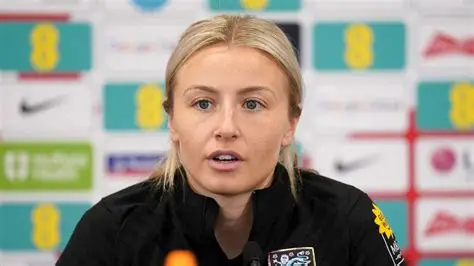

When the votes were tallied for the 2025 National Player of the Year, the choice was resounding: Leah Williamson, the quietly authoritative centre-back who has become the heartbeat of Arsenal W.F.C.’s back line. At only twenty-eight years old and still classified as a “sophomore” in the Women’s Super League because 2024–25 was just her second full campaign after returning from ligament surgery, Williamson has already rewritten expectations for what a modern defender can be. The honor crowns a season in which she shepherded a rebuilt Arsenal side to a league title, guided England to Olympic silver, and elevated the art of defensive play to something approaching choreography.
Born on 29 March 1997 in Milton Keynes, Williamson grew up fascinated by dualities: ballet and football, mathematics and music, solitude and teamwork. These pairs still shape her approach. On the pitch she is simultaneously the metronome and the improviser, measuring risk in split-second calculations while trusting an instinct for spatial geometry that seems preternatural. Standing 5 ft 7 in (170 cm), she is not the tallest centre-back in England, yet she dominates aerial duels through timing and core strength. Her jump is powered by a stance coaches describe as “sprinter-ready,” a posture drilled during long rehabilitation sessions after her 2023 ACL tear. That injury could have defined her, but instead it furnished the resilience and biomechanical efficiency that now underpin her game.
Arsenal’s 2024–25 statistics illuminate her influence. The Gunners conceded a league-low 0.62 goals per match and kept fifteen clean sheets in twenty-four games. Williamson completed 91 % of her passes, but raw accuracy understates the ambition of her distribution. She ranked first among WSL defenders in line-breaking passes—balls that eliminate four or more opposition players—and second in progressive carry distance. These metrics quantify what fans witness with the naked eye: a defender who turns platform into springboard, defense into launchpad. When she steps forward into midfield, tempo shifts; wingers flare wide, full-backs tuck in, and Arsenal morph into a 3-2-5 puzzle that opponents struggle to solve.
Leadership, though, cannot be reduced to numbers. Manager Jonas Eidevall credits Williamson with what he calls “the silent orchestra cue.” In training she studies opponents’ pressing triggers, then scripts Arsenal’s rehearsed escapes: a decoy pass, an inverted run, a sudden switch. On match day she offers subtle reminders—a glance, a finger point, the tilt of a shoulder—rather than barking orders. Teammates say they can “hear” her without words. That economy of communication became crucial in October’s North London derby, when a torrential downpour drowned out touchline instructions. Arsenal were pinned in, level at 1-1, and Spurs sensed momentum. Williamson drifted ten meters left, triggering a chain reaction that pulled Tottenham’s press off balance; three passes later, Arsenal were through on goal. They won 3-1, and pundits later traced the turning point to that single, almost invisible, positional nudge.
Her résumé already glittered before 2025: a European Championship with England in 2022, a World Cup finals appearance in 2023, and the captaincy of club and country. Yet this season’s award feels distinct because it honors mastery rather than promise. Post-injury, Williamson’s minutes were managed carefully—she started only thirty-one of Arsenal’s forty-two competitive fixtures—but within those limits she played with total assurance. Perhaps the defining image came in the Champions League quarter-final second leg against Lyon. Facing a two-goal aggregate deficit, Arsenal pressed high, leaving vast space behind them. Williamson, isolated against Catarina Macario, anticipated a through-ball seconds before it was played, sprinted thirty meters, and slid to shepherd it out for a goal kick. The tackle was technically impeccable; more impressive was the serenity with which she executed it under existential pressure.
Off the field Williamson has emerged as an advocate for athlete welfare and educational opportunity. She recently completed a distance-learning degree in economics, presenting a dissertation on revenue sharing in women’s sport. Her Instagram feed alternates between tactical breakdowns and recommendations for science podcasts. Younger teammates recount evenings at team hotels where Williamson leads impromptu seminars on compound interest or biomechanics, drawing diagrams on napkins next to a stack of match DVDs. That polymath curiosity reinforces her belief that footballers are “problem-solvers first, athletes second,” a mantra that shapes Arsenal’s analytical culture.
The National Player of the Year voters cited “transformative leadership” in their citation, but Williamson’s influence extends further. She is redefining the archetype of the English centre-back from sheer physical enforcer to cerebral orchestrator—a shift mirrored in grassroots academies where coaches now teach ten-year-olds to scan over their shoulder and thread diagonals instead of simply clearing long. Her journey also underscores the value of patience in a sport addicted to immediacy. By embracing what she calls “the slow build,” Williamson transformed a traumatic injury into a postgraduate course in proprioception, nutrition, and sports psychology. The result is an athlete who thinks in seasons, not cycles, and who measures success by collective harmony rather than individual spectacle.

What comes next? In the near term, Arsenal will rely on her to anchor a Champions League push and to mentor the teenage phenom Amelia Obasi, whom Williamson has already nicknamed “Little Geometry” for her angular passing. England, eyeing the 2027 World Cup, see in her the continuity between generations. Yet Williamson speaks of broader ambitions: establishing a player-led research fund on injury prevention and lobbying for equal medical resources across women’s leagues. If the arc of her career proves anything, it is that leadership, like defending, can be both art and science—a choreography of space, time, and trust. The 2025 National Player of the Year trophy merely formalizes what Arsenal supporters and opponents alike have long accepted: Leah Williamson stands at the nexus of intellect and instinct, guiding the game toward its future one perfectly weighted pass at a time.
Leave a Reply